The light for cannabis (marijuana)
Cannabis for her life needs good lights. Through the process of photosynthesis, it converts the energy of light into the energy of chemicals. The main role in this transformation is played by the photosynthetic pigment - chlorophyll. It plays the role of a kind of “feeler” that absorbs the energy radiated by the sun. Then it is stored inside cannabis using biological membranes. This process can be represented in the form of certain ability, due to which the absorption and use of quantum light energy for the transformation of carbon dioxide into organic matter takes place. They are necessary for marijuana to build her own body and perform different catabolic processes.
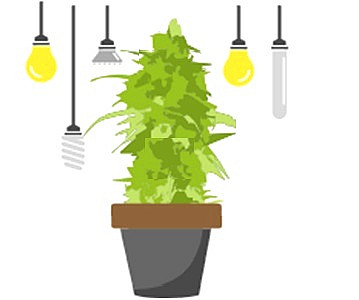
However, cannabis does not need all the light, but only its individual spectra. The most significant for her are:
Graph of plant growth activity depends of light wavelength.
• Blue with a wavelength of 430-470 nm. It is especially needed for the growing period. With its help, stimulate the production of chlorophyll B, necessary for the development of the root system, leaves and branches;
• Red with a wavelength of 620-700 nm. It has an important role in the flowering process of cannabis. With its help, chlorophyll A is created, which is responsible for development of the roots and buds;
• Infrared radiation with a wavelength range between 730 nm and 30 microns. It is used by the plant to accelerate metabolism, which leads to an increase of the rate of growth and development;
• Ultraviolet radiation. Its wavelength varies from 10 to 400 nm. Cannabis needs it for the production of resin, which in nature protects the plant from negative environmental factors. Its increased amount will positively affect the quality of the cannabis cones.
Outdoor Lighting
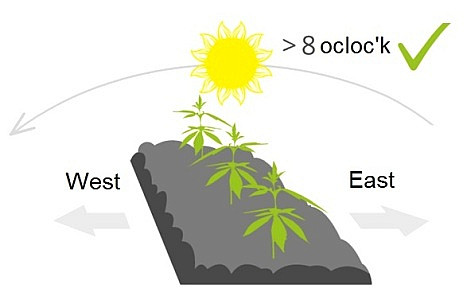
Lighting cannabis in the outdoor is engaged by Mother Nature. Therefore, the grower should cultivate the plants where there is as much light as possible. This place must be in direct sunlight for at least 8-10 hours a day. The shadows on the place should be as small as possible. Best of all, if at noon it will create a partial shade and it direct rays do not burn the plant.
The seeds should be planted perpendicular to the axis of movement of the sun, and all the bushes will receive the same amount of light. This will allow them to develop synchronously, which will result in stable yield indicators.
Everything must be done and marijuana receives a lot of light. If some branches create a shadow - cut them off. Too much sun for lunch - create a canopy of material or branches.
The planting can be done no later than a month before the summer solstice. After this day, the duration of the sun’s stay in the sky will begin to decrease, which will not allow the plant to develop enough before the onset of flowering.
It should be understood that only auto-flowering cannabis varieties will be able to grow stronger in a month. Photoperiod seeds must be planted when it will be worm, when the air temperature at night becomes no lower than 10-15 degrees. By this time, the sun will certainly already provide enough light for the normal development of cannabis.
Indoor Lighting

In closed ground, marijuana lighting is work of the grower completely. Without an artificial light source he simply can not do it. Lamps for growing cannabis must have sufficient power and the correct spectral composition of light so that the plant can fully realize the growth potential and yield. The most common lamps in the grower’s environment today are:
• Sodium gas discharge (HPS). Until recently, it was considered the best lamp for the cultivation of cannabis. They emit increased proportions of red and blue spectra, which allows the plant to feel comfortable. The main disadvantage of HPS lamps is that they become very hot during operation. As a result, the air temperature in the grow box rises significantly, and this is a problem for the all the growers. When using sodium discharge lamps, ventilation is indispensable. They also need special lights and they are environmentally unsafe;
• Energy Saving (CFL). Such lamps consume much less electricity than sodium. They practically do not heat up during operation, which only slightly affects the temperature in the box. However, only 2 types of CFL are best suited for cannabis cultivation - 2700k and 6400k. For full lighting, the grower will have to use two at the same time, since the blue spectrum dominates in the one and the red spectrum in the second. They can also be used apart;
• LED. Special LED phytolamps are considered the most suitable for growing cannabis today. Their value has fallen significantly over the past few years, that is why all the growers can easily buy them. They consume very little power and do not heat up during operation. Their maximum temperature is 40 degrees. There is bicolor, multicolor and a full range of LED phytolamps.
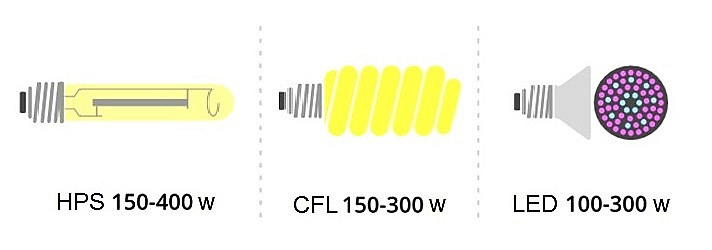
As of the required light output, the following indicators are considered standard depending on the type of lamp:
• CLF - from 150 to 300 W;
• HPS - 150-400 W;
• LED - 100-300 watts.
The maximum value is recommended to be chosen when the cultivation area is close to 1 m2, and the minimum for one bush. It is also worth to remember that at the vegetation stage, the plant needs a blue light spectrum more, and red for flowering. In order to have more resin, you should put ultraviolet lamps to the light during the ripening period of the inflorescences.
Light mode for photoperiodic and autoflowering varieties
Autoflowering cannabis varieties are more neglectful of the light regime. For them, it can be the same all their life. Most often, growers choose 18/6 or 20/4. However, there are those who put 24/0. This is a rather dubious decision, because the plant should rest at night.

Light modes for the vegetation and flowering stages of the photoperiodic marijuana variety are different. During the growth period, 18/6 or 20/4 should be established. Once the cannabis bush reaches its maximum size, it will need to be converted to flowering. To do this, you need to change the light mode to 12/12, saving it until the harvest.
If for some reason the photoperiod cultivar finds itself in complete darkness on vegetation for several days, then it will certainly begin to bloom, no matter how small it is. This type is unacceptable for growers, since a completely unformed bush will not be able to bring the maximum amount of yield.

But, if you turn off the light a couple of days before the marijuana harvest, then this will make the bumps become more resinous. But exactly in the tar and trachoma’s that THC is contained. Cannabis growers use this technique quite often when grown in indoor, thereby increasing the quality of the finished product.
Lack and oversupply of lights for cannabis
A cannabis bush, which has enoughts of light, will vigorously gain green mass and develop. Its leaves will have a rich color and regular geometric shape. Their tips will not change color or dry out. Therefore, it is worth correctly calculating the distance from marijuana to lamps.
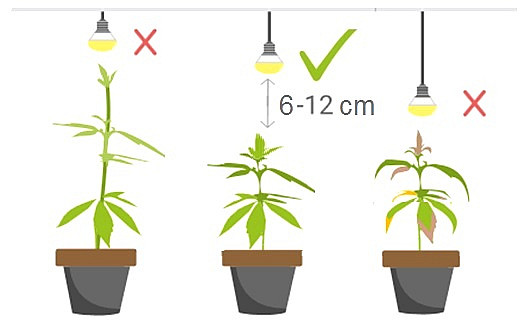
Problems with the plant can begin as a result of both a lack of light and its overabundance.
The most popular signs of a lack of lighting are:
• Cuttings are elongated and disproportionate shapes. Their thin stems always bend towards the light, stretching leaves towards it;
• Marijuana leaves begins to fade and take on a lifeless appearance. Shoots grow thin and lethargic. Closer to the harvest, they often have to be tied up so that they do not break under the weight of inflorescences;
• Bushes are highly elongated and practically do not grow in breadth. They spend too much energy striving to be closer to the light source. As a result, cannabis becomes unable to actively develop secondary shoots;
• If there is a lack of light, marijuana will begin to turn yellow. The aggravation of the problem can lead to the death of leaves and branches. Especially often this happens with the lowest leaves. With the main stem this happens least often.
Too much light for marijuana
With too much light, cannabis feels light stress. Most often, it begins to appear on those leaves and branches that are closest to the light source. Changes begin to occur gradually in 3-5 days. They affect the cellular level of the stump, leading to its inability to develop normally.
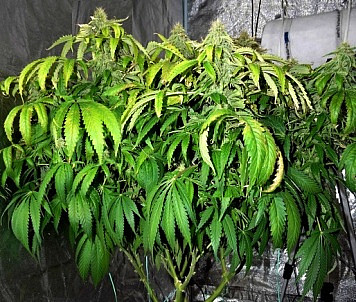
The order:
• The leaves start to be pale;
• The tips of the leaves turn yellow;
• The yellowed tips begin to dry;
• The edge of the leaf becomes brittle;
• The leaves fallen down.
If the plant gets light stress during flowering period, this will significantly spoil the grower's crop. Strong light is able to “burn out” THC, as well as accelerate the process of its decay into cannabinoid CBN undesirable for grower. You should look at the inflorescences carefully, immediately moving the lamp away from them in case of yellow shades.
In conclusion …
We can say with confidence that enough light can significantly increase the performance of any kind of cannabis. It is a source of energy for the vital processes of the plant, without which it just cannot exist. But too much light can also harm cannabis, causing it light stress.
In an outdoor, growers should take a responsible approach to choosing a landing site. The place should be in the sun 8-10 hours a day.
In the indoor, you have to select the most suitable lamp for marijuana, given its power and the spectral composition of the emitted light. You have to care after appearance of the plant. At the first sign of a lack or overabundance of lighting, measures should be taken immediately, because this threatens low productivity.
Buy now a quality cannabis seeds on our website.
*All information provided is for informational purposes only and is not a guide or call to action.
** We remind you that the use of marijuana seeds as a sowing material (cultivation of cannabis in order to obtain a plant) is crime in many countries.












